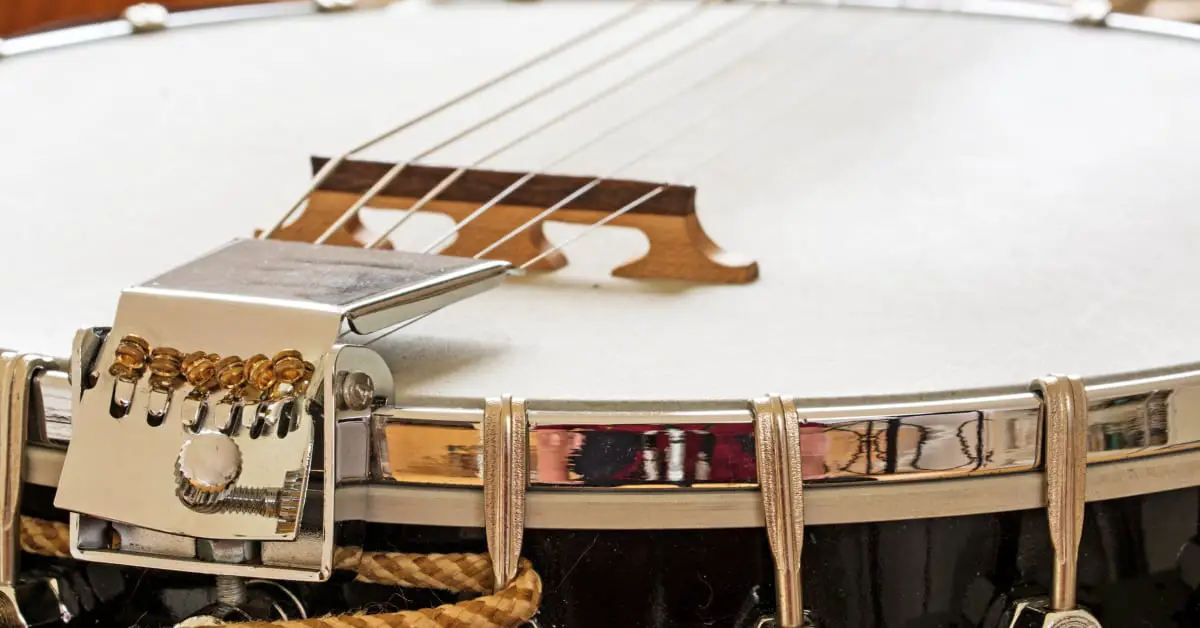One of the simplest and most convenient ways to change the key of your banjo is through the use of a capo. However, to achieve this, you will need a separate fifth string capo since most of them are elevated. This, in conjunction with another capo, will effortlessly change the key that you are playing in without having to retune your banjo strings.
Type Of Capo Applicable For Banjos:
Traditional Four Fret Capo
As the name implies, traditional capos are applicable to only the first four frets and are always available online or at almost every music store. There are three kinds of traditional capos: elastic, clamp, and screw. Even though their purpose may be similar, they still differ in some aspects.
- Elastic capos are typically the most affordable.
- Clamp capos utilize a spring to generate tension.
- Screw capos are the most popular capo used for banjos. It enables users to adjust the tension of the strings.
Sliding Capo For Fifth String
Shubb sliding capos are designed specifically for banjos and may be moved up and down the neck past the fourth fret. These capos must be screwed into the neck of the banjo. Hence, it is highly suggested to seek assistance from a luthier or banjo specialist in installing them to ensure that they are secured and that your banjo doesn’t get damaged.
Railroad Spikes
Railroad spikes can be used as a capo for the fifth string by inserting them into holes bored into the frets. Bring your banjo to a luthier or other professional who works with musical string instruments to get it installed. The railroad spike is typically placed between the seventh and tenth fret.
Things To Consider When Using Different Capos On The Banjo:
- Position your capo close to the fret.
It is important to tighten the capo and position it as close to the fret as possible rather than on top. This will prevent the capo from pulling the strings out of tune.
- Avoid tightening the capo too much
If you tighten the capo too much, it will buzz and pull your banjo strings out of tune. Instead, tighten them just enough to hear the strings clearly when you play them. A great technique is to strum the strings every time you tighten the capo until you hear clear sounds.
- Unscrew and slide a sliding capo
To adjust a sliding capo, turn the small screw located on top of the cap counterclockwise to unscrew it. This will allow you to slide the capo back and forth in the fret you want it to be. Remember that Shubb sliding capos are better to be installed by a professional since it involves screwing into the neck of your banjo.
- Squeeze the clamp capo’s handles to open it when placing them
The spring tension holds a clamp capo together. To position a capo in place, simply squeeze both handles just enough for its jaws to open. While it’s open, set it onto the neck of your banjo on the fret that you desire. Doing so prevents your strings from being pulled out of tune.
- Pull and position the fifth string under a railroad spike
To use railroad spikes, pull the fifth string under it so that it lies on top of the string. This change the note you are playing on the fifth string and holds them in place at the railroad spike.
- Wrap the elastic capo around the frets
In tightening elastic capos, locate the hook and fit it onto the hole on the capo. Afterward, wrap the capo around the fret you want to play, then loop the capo’s hook through the hole. When using this type of capo, make sure that it’s tight enough to hold down the banjo’s bottom four strings.
Playing Banjos With Capos:
To Change The Key, Use The Capo On The First Four Strings
A banjo’s standard tuning is in the key of G. Your strings would be tuned to G, D, G, B, and D in this situation. Using a capo on the first four frets is comparable to holding the frets down in a barre chord and will surely change the key you’re playing in.
- In standard tuning, bringing the capo to the second fret puts you in the key of A.
- You may play in the key of B flat by tightening the capo on the third fret.
- You can play in the key of B by putting the capo on the fourth fret.
In Addition To Your Capo, Use A Fifth Fret Capo
Placing a capo for the fifth string changes its note and works in conjunction with the capo on the first four frets to change the key you’re playing in.
- When playing in the key of A, your first capo will be on the second fret, while your other capo will be on the seventh fret for the fifth string.
- If you’re playing in the key of B, your standard capo should be on the fourth fret, while your fifth string capo should be on the ninth fret.
When Changing The Key, Use Capos To Keep The Same Chord Shapes.
A capo allows you to effortlessly alter your banjo’s key without having to retune it. One of its many benefits is its ability to maintain typical chord forms while playing in a different key. For example, if you know a song in the key of G, you can use a capo on the bottom four strings of the second fret and the fifth string of the seventh fret while keeping the same finger positions. The capo will take care of everything and adjust the song’s key from G to A.


